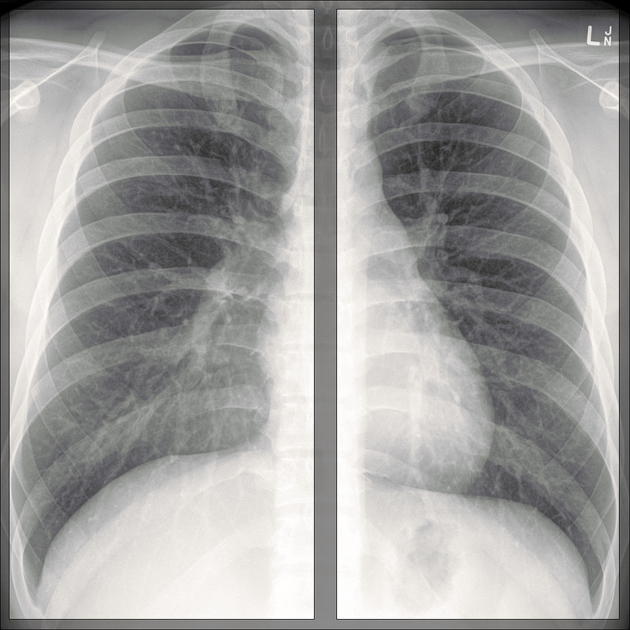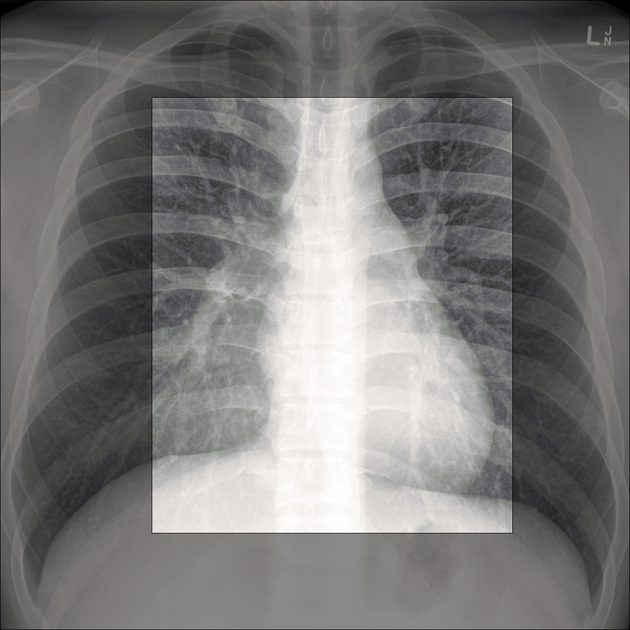Chest x-ray review is a key competency for medical students, junior doctors and other allied health professionals. Using A, B, C, D, E, F is a helpful and systematic method for chest x-ray review:
A: airways (intraluminal mass, narrowing, splayed carina)
B: breathing (lungs, pulmonary vessels, pleural spaces)
C: circulation (cardiomediastinal contour, great vessels)
D: diaphragm and below (diaphragmatic paresis, pneumoperitoneum, gaseous distension, splenomegaly, calculi)
E: external e.g. chest wall (ribs, shoulder girdles, fractures), soft tissues
F: foreign material (devices, foreign bodies, gossypibomas)
On this page:
Airways
Start at the top in the midline and review the airways.
-
trace the trachea down to the carina and main bronchi
the trachea should be midline at the sternal notch, deviates to the right around the aortic arch and divides into the right and left main bronchi with an angle less than 105’ (mean 80’)
any narrowing or intraluminal lesion?
-
trace down both main bronchi
is the carina wide (more than 105 degrees)?
is there bronchial narrowing or cut-off?
is there any inhaled foreign body?
Read more: chest x-ray assessment of the airways
Breathing
Look for lung and pleural pathology.
-
both lungs should be well expanded and similar in volume
can you count 10 posterior ribs bilaterally?
is one lung larger than the other?
-
compare the apical, upper, middle and lower zones in turn
are they symmetrical?
are there areas of increased density?
-
trace the lung vessels
can you see the vasculature equally throughout both lungs?
can you see the retrocardiac and retrodiaphragmatic lung vessels?
are there extra lines in the periphery that aren't vessels?
-
trace the lateral margins of the lung to the costophrenic angles
are the costophrenic angles crisp?
-
trace the hemidiaphragms to the vertebrae
can you see the whole of the hemidiaphragm?
-
trace the cardiac borders
can you clearly see the left and right heart borders?
can you see the descending aorta?
check the heart shadow for retrocardiac lung opacity
check the diaphragm for overlying lung lesions in the posterior costophrenic recesses
Read more: chest x-ray assessment of lungs and pleural spaces
Circulation
Look at the heart and vessels (systemic and pulmonary).
-
check the cardiac position
is 1/3 to the right and 2/3 to the left?
-
assess cardiac size
is the cardiothoracic ratio <50%?
check the position and size of the aortic arch and pulmonary trunk
check the width of the upper mediastinum
-
look at the hilar vessels
can you see them clearly on both sides?
are they at a similar height?
can you see a preserved hilar point bilaterally and a little higher on the left?
Read more: chest x-ray assessment of the cardiomediastinum
Diaphragm and below
is the right hemidiaphragm the same height or up to 2 cms higher than the left hemidiaphragm?
is there a hiatus hernia?
can you identify the gastric bubble, splenic flexure of the colon and spleen?
is there any free intraperitoneal gas?
is the stomach or bowel dilated?
are there any gallbladder or renal calculi?
Read more: chest x-ray assessment of the diaphragm
External (chest wall, shoulder girdles etc)
Check for any bone pathology (fracture or metastasis) and soft tissue symmetry
equal companion shadows superior to both clavicles
symmetrical or left slightly lower breast shadows?
soft tissue emphysema?
-
trace along each posterior (horizontal) rib on one side of the chest
is there a fracture or area of destruction?
repeat with the other side of the chest
now trace lateral and anterior ribs on the first side
repeat on the other side
-
now check the clavicles and shoulder girdles for bone destruction or dislocation
can you trace around the cortex of the bones?
-
check the vertebral bodies; at each level you should see two eyes (pedicles), a mouth (interlaminar space) and a nose (spinous process):
are the bodies rectangular and of a similar height?
can you see 2 pedicles per vertebral body?
are there disc spaces?
Foreign material
Review the upper abdomen, soft tissues and chest
are there any surgical clips?
are there any devices?
are lines and tubes in a satisfactory position?
are there any unexpected foreign bodies such as retained swabs?
Read more: chest x-ray assessment of everything else







 Unable to process the form. Check for errors and try again.
Unable to process the form. Check for errors and try again.